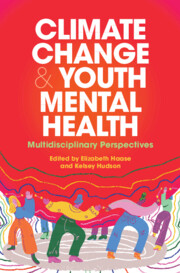Book contents
- Climate Change and Youth Mental Health
- Climate Change and Youth Mental Health
- Copyright page
- Contents
- Figures
- Tables
- Textboxes
- Contributors
- Preface and Introduction
- Considerations
- Acknowledgments
- Part I Conceptual Foundations of Climate Distress in Young People
- Part II Multidisciplinary Perspectives on Youth Climate Distress
- Chapter 10 Therapists’ Perspectives
- Chapter 11 Ecological and Intersectional Perspectives to Reduce Young Adults’ Climate Distress
- Chapter 12 Pediatricians’ Perspectives
- Chapter 13 A Legal Perspective on Judicial Remedies to Respond to Young People’s Climate Distress
- Chapter 14 Coping with Climate Change among Young People
- Chapter 15 Social-Ecological Perspectives and Their Influence on Climate Distress in Young People
- Chapter 16 Parenting and Grandparenting Our Youth in the Climate Crisis
- Chapter 17 Perspectives on Addressing Young People’s Climate Distress in Education
- Chapter 18 Activists’ Perspectives
- Chapter 19 Perspectives from Creative Spaces
- Chapter 20 Landback
- Chapter 21 Future Directions
- Appendix A Resource List for Educators
- Appendix B Costs and Benefits of Activism Scale
- Index
- References
Chapter 14 - Coping with Climate Change among Young People
Meaning-Focused Coping and Constructive Hope
from Part II - Multidisciplinary Perspectives on Youth Climate Distress
Published online by Cambridge University Press: 06 June 2024
- Climate Change and Youth Mental Health
- Climate Change and Youth Mental Health
- Copyright page
- Contents
- Figures
- Tables
- Textboxes
- Contributors
- Preface and Introduction
- Considerations
- Acknowledgments
- Part I Conceptual Foundations of Climate Distress in Young People
- Part II Multidisciplinary Perspectives on Youth Climate Distress
- Chapter 10 Therapists’ Perspectives
- Chapter 11 Ecological and Intersectional Perspectives to Reduce Young Adults’ Climate Distress
- Chapter 12 Pediatricians’ Perspectives
- Chapter 13 A Legal Perspective on Judicial Remedies to Respond to Young People’s Climate Distress
- Chapter 14 Coping with Climate Change among Young People
- Chapter 15 Social-Ecological Perspectives and Their Influence on Climate Distress in Young People
- Chapter 16 Parenting and Grandparenting Our Youth in the Climate Crisis
- Chapter 17 Perspectives on Addressing Young People’s Climate Distress in Education
- Chapter 18 Activists’ Perspectives
- Chapter 19 Perspectives from Creative Spaces
- Chapter 20 Landback
- Chapter 21 Future Directions
- Appendix A Resource List for Educators
- Appendix B Costs and Benefits of Activism Scale
- Index
- References
Summary
Based on earlier empirical research, the main aim of this chapter is to argue for the importance of promoting meaning-focused coping and constructive hope in relation to climate change among young people. We start by describing the role of meaning and positive emotions like hope in the coping process and how meaning-focused coping and constructive hope are interrelated. Thereafter, we describe several aspects of meaning-focused coping in relation to the climate threat and show that this way of coping is associated with both mental well-being and climate change engagement. We also review some studies that demonstrate how collective climate engagement can give hope and meaning to young activists. The chapter also aims to discuss the practical implications of these studies, both for different groups of adults who want to communicate with youth about climate change in a constructive way (like parents and teachers) and for young people themselves. We finish the chapter by emphasizing the need for promoting critical emotional awareness where it is acknowledged that emotions and coping are not solely individual experiences but are also influenced by cultural emotion norms, gender norms, and power. The age groups in focus are adolescents and emerging adults.
Keywords
- Type
- Chapter
- Information
- Climate Change and Youth Mental HealthMultidisciplinary Perspectives, pp. 269 - 286Publisher: Cambridge University PressPrint publication year: 2024

